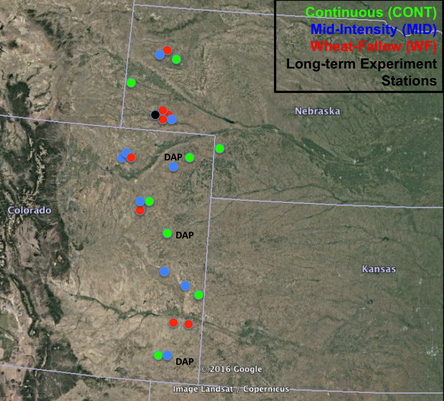DRYLAND CROPPING SYSTEM INTENSIFICATION IN THE HIGH PLAINS:
IMPACTS AND BARRIERS TO ADOPTION

Winter wheat-fallow remains one of the dominant dryland agricultural systems in the High Plains. Long-term experiments have demonstrated that, in conjunction with no-till, intensifying cropping systems beyond wheat-fallow by adding other crops like corn, sorghum, sunflowers, peas, or millet into the rotation can increase profitability, soil health, and overall food production. However, much is still unknown about the effects of cropping system intensification in different soil types, climates, and management styles.
Through plant and soil sampling on 96 fields from 30 working dryland no-till farms and 4 long-term agricultural experiment stations (see figure), in addition to interviews with 30 farmers across a range of cropping intensities, this project will generate a better understanding of how intensified cropping systems affect:
Finally, a landscape-scale spatial analysis of crop rotations will be conducted to quantify adoption of intensified cropping systems over time and space. This will allow us to assess the current rate of adoption, and speculate about the broader implications of increased adoption of intensified cropping systems for food production, carbon sequestration, and the use of agrichemicals.
Through plant and soil sampling on 96 fields from 30 working dryland no-till farms and 4 long-term agricultural experiment stations (see figure), in addition to interviews with 30 farmers across a range of cropping intensities, this project will generate a better understanding of how intensified cropping systems affect:
- Soil carbon storage and aggregation
- Soil microbial community structure
- The symbiosis between winter wheat and arbuscular mycorrhizal fungi, and its implications for enhanced phosphorus uptake
- Herbicide and fertilizer use
- Winter wheat and annualized grain yields
Finally, a landscape-scale spatial analysis of crop rotations will be conducted to quantify adoption of intensified cropping systems over time and space. This will allow us to assess the current rate of adoption, and speculate about the broader implications of increased adoption of intensified cropping systems for food production, carbon sequestration, and the use of agrichemicals.
